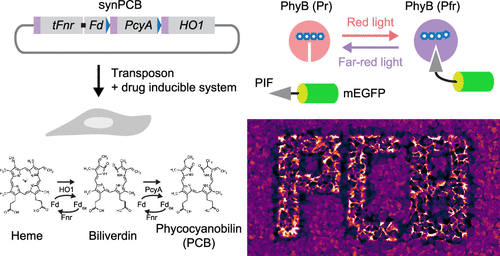当前位置:
X-MOL 学术
›
ACS Chem. Biol.
›
论文详情
Our official English website, www.x-mol.net, welcomes your feedback! (Note: you will need to create a separate account there.)
Improvement of Phycocyanobilin Synthesis for Genetically Encoded Phytochrome-Based Optogenetics
ACS Chemical Biology ( IF 4 ) Pub Date : 2020-11-09 , DOI: 10.1021/acschembio.0c00477 Youichi Uda 1, 2, 3 , Haruko Miura 1, 2 , Yuhei Goto 1, 2, 4 , Kei Yamamoto 1, 2, 4 , Yusuke Mii 1, 2 , Yohei Kondo 1, 2, 4 , Shinji Takada 1, 2 , Kazuhiro Aoki 1, 2, 4
ACS Chemical Biology ( IF 4 ) Pub Date : 2020-11-09 , DOI: 10.1021/acschembio.0c00477 Youichi Uda 1, 2, 3 , Haruko Miura 1, 2 , Yuhei Goto 1, 2, 4 , Kei Yamamoto 1, 2, 4 , Yusuke Mii 1, 2 , Yohei Kondo 1, 2, 4 , Shinji Takada 1, 2 , Kazuhiro Aoki 1, 2, 4
Affiliation

|
Optogenetics is a powerful technique using photoresponsive proteins, and the light-inducible dimerization (LID) system, an optogenetic tool, allows to manipulate intracellular signaling pathways. One of the red/far-red responsive LID systems, phytochrome B (PhyB)–phytochrome interacting factor (PIF), has a unique property of controlling both association and dissociation by light on the second time scale, but PhyB requires a linear tetrapyrrole chromophore such as phycocyanobilin (PCB), and such chromophores are present only in higher plants and cyanobacteria. Here, we report that we further improved our previously developed PCB synthesis system (SynPCB) and successfully established a stable cell line containing a genetically encoded PhyB-PIF LID system. First, four genes responsible for PCB synthesis, namely, PcyA, HO1, Fd, and Fnr, were replaced with their counterparts derived from thermophilic cyanobacteria. Second, Fnr was truncated, followed by fusion with Fd to generate a chimeric protein, tFnr-Fd. Third, these genes were concatenated with P2A peptide cDNAs for polycistronic expression, resulting in an approximately 4-fold increase in PCB synthesis compared with the previous version. Finally, we incorporated the PhyB, PIF, and SynPCB system into drug inducible lentiviral and transposon vectors, which enabled us to induce PCB synthesis and the PhyB-PIF LID system by doxycycline treatment. These tools provide a new opportunity to advance our understanding of the causal relationship between intracellular signaling and cellular functions.
中文翻译:

基于基因编码植物色素的光遗传学中藻蓝素合成的改进。
光遗传学是一种使用光响应蛋白的强大技术,而光诱导二聚化(LID)系统(一种光遗传学工具)可以操纵细胞内信号传导途径。红色/深红色LID系统之一是植物色素B(PhyB)-植物色素相互作用因子(PIF),具有在第二时间尺度上控制光的缔合和解离的独特特性,但是PhyB需要线性四吡咯发色团例如藻蓝蛋白(PCB),此类生色团仅存在于高等植物和蓝细菌中。在这里,我们报告说,我们进一步改进了先前开发的PCB合成系统(SynPCB),并成功建立了包含遗传编码的PhyB-PIF LID系统的稳定细胞系。首先,负责PCB合成的四个基因PcyA,HO1,Fd和Fnr替换为源自嗜热蓝细菌的对应物。其次,将Fnr截短,然后与Fd融合以产生嵌合蛋白tFnr-Fd。第三,将这些基因与P2A肽cDNA连接起来进行多顺反子表达,与以前的版本相比,导致PCB合成增加了约4倍。最后,我们将PhyB,PIF和SynPCB系统整合到药物诱导的慢病毒和转座子载体中,这使我们能够通过强力霉素处理诱导PCB合成和PhyB-PIF LID系统。这些工具为增进我们对细胞内信号传导与细胞功能之间的因果关系的理解提供了新的机会。
更新日期:2020-11-21
中文翻译:

基于基因编码植物色素的光遗传学中藻蓝素合成的改进。
光遗传学是一种使用光响应蛋白的强大技术,而光诱导二聚化(LID)系统(一种光遗传学工具)可以操纵细胞内信号传导途径。红色/深红色LID系统之一是植物色素B(PhyB)-植物色素相互作用因子(PIF),具有在第二时间尺度上控制光的缔合和解离的独特特性,但是PhyB需要线性四吡咯发色团例如藻蓝蛋白(PCB),此类生色团仅存在于高等植物和蓝细菌中。在这里,我们报告说,我们进一步改进了先前开发的PCB合成系统(SynPCB),并成功建立了包含遗传编码的PhyB-PIF LID系统的稳定细胞系。首先,负责PCB合成的四个基因PcyA,HO1,Fd和Fnr替换为源自嗜热蓝细菌的对应物。其次,将Fnr截短,然后与Fd融合以产生嵌合蛋白tFnr-Fd。第三,将这些基因与P2A肽cDNA连接起来进行多顺反子表达,与以前的版本相比,导致PCB合成增加了约4倍。最后,我们将PhyB,PIF和SynPCB系统整合到药物诱导的慢病毒和转座子载体中,这使我们能够通过强力霉素处理诱导PCB合成和PhyB-PIF LID系统。这些工具为增进我们对细胞内信号传导与细胞功能之间的因果关系的理解提供了新的机会。



























 京公网安备 11010802027423号
京公网安备 11010802027423号